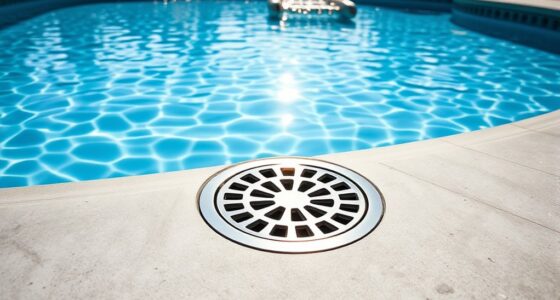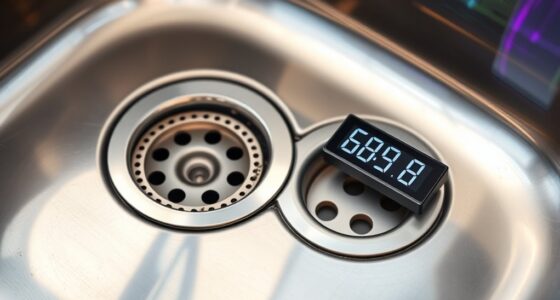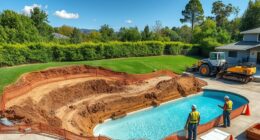To lifeguard your backyard effectively, start by evaluating hazards like uneven ground, weak fences, or uncovered water features. Equip your space with safety gear, signage, and alarms, and establish clear emergency response plans. Supervise children constantly and teach family members basic water safety skills. Regular drills, safety checks, and clear communication ensure everyone knows what to do. Keep emergency supplies nearby; staying prepared can prevent accidents and save lives. Discover more tips to create a safer backyard environment.
Key Takeaways
- Regularly assess and eliminate backyard hazards, ensuring fences, pools, and pathways are secure and well-maintained.
- Install safety equipment like life rings, alarms, and clear signage to alert and assist during emergencies.
- Develop and practice a detailed emergency response plan with assigned roles and regular drills.
- Provide water safety training to family and guests, emphasizing rescue techniques and hazard recognition.
- Keep a well-stocked first aid kit and reliable communication devices ready for quick response.
Assessing Your Backyard Safety Risks
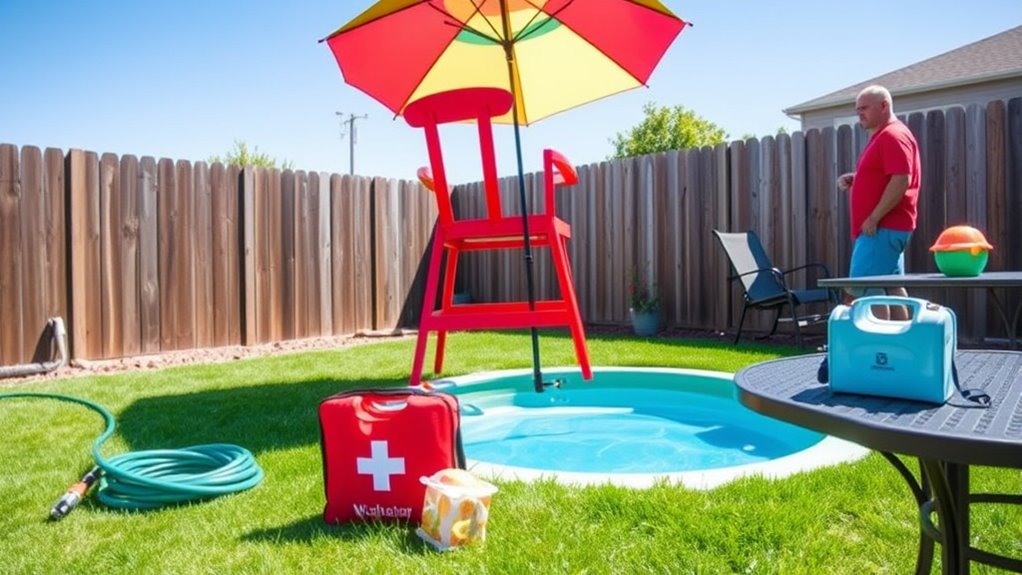
Before setting up safety measures, you need to identify potential hazards in your backyard. Walk around carefully and look for anything that could cause injury or pose a risk. Check for uneven ground, sharp edges, or objects that could trip someone. Examine fences for gaps or weaknesses that a child could slip through. Look for pool or pond areas that lack proper barriers or warning signs. Consider the location of gardening tools, hoses, or chemicals that could be dangerous if accessed by children. Pay attention to areas with poor lighting, which can hide hazards at night. By thoroughly evaluating these risks, you’ll know where to focus your safety efforts and prevent accidents before they happen. Incorporating sound vibrations or other calming elements can also help create a safer, more relaxing environment.
Essential Safety Equipment for Your Pool or Pond
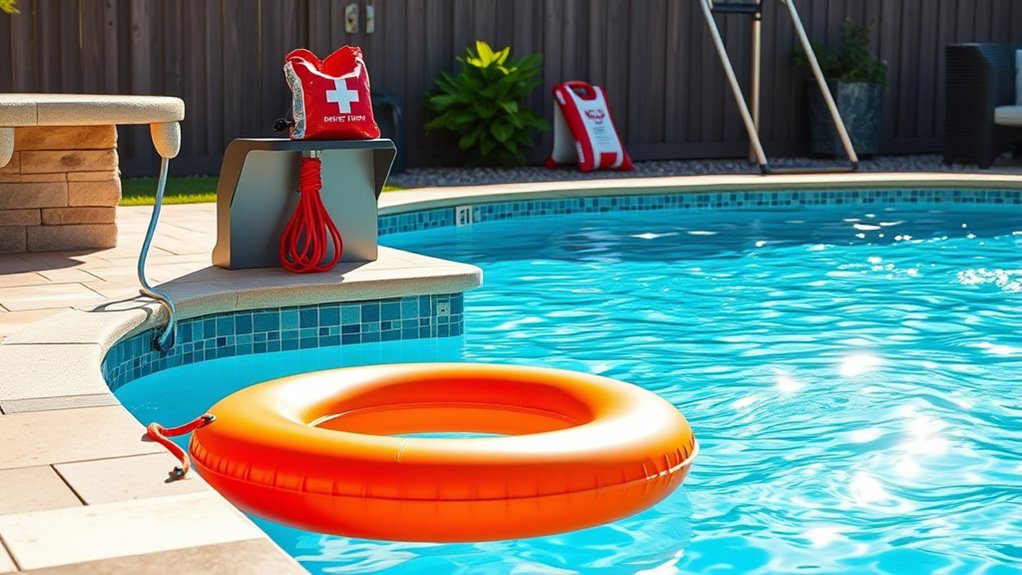
Having the right safety equipment on hand is vital for preventing accidents around your pool or pond. You should equip yourself with essential safety gear like life rings, poles, and first aid kits, ready for any emergency. Additionally, water rescue equipment can make all the difference if someone needs help quickly.
Pool Safety Gear Essentials
Ensuring your pool or pond is safe requires having the right safety gear on hand. First, keep a sturdy life ring or reaching pole nearby for quick rescues. A pair of goggles or gloves can protect you if you need to handle someone in distress. Install a pool alarm that alerts you if someone enters unsupervised. Keep a first aid kit close to address minor injuries promptly. Having a waterproof rescue throw or throw rope guarantees you can assist without putting yourself at risk. Additionally, verify all safety equipment is in good condition and easily accessible. Regularly check your gear for wear and replace it as needed. Being prepared with the right safety gear can make all the difference during an emergency. Proper safety equipment is essential for effective incident management and prevention.
Water Rescue Equipment
Water rescue equipment is an essential component of your pool or pond safety setup, providing the tools needed to respond quickly in an emergency. Having the right equipment nearby can make all the difference in saving a life. Key items include rescue poles, life rings, and waterproof throwing ropes. These tools allow you to reach and assist a struggling swimmer safely and efficiently. Keep equipment easily accessible and regularly inspect it for damage or wear. Use the following table as a quick reference for essential rescue gear:
| Equipment | Purpose |
|---|---|
| Rescue Pole | Extend reach to a distressed swimmer |
| Life Ring | Provide buoyancy support |
| Throw Rope | Securely toss to someone in trouble |
Having these essentials ready ensures you’re prepared to act confidently and effectively. Proper training and familiarity with this equipment improve response times and can be crucial during emergencies.
Creating a Clear Emergency Action Plan
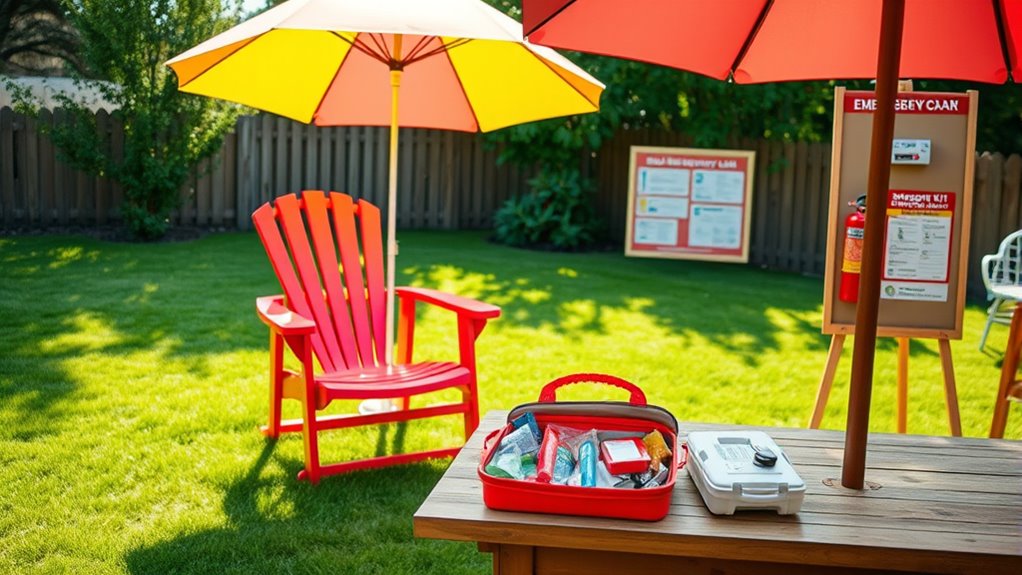
You need a solid emergency action plan to keep everyone safe if something goes wrong. Start by identifying potential emergency scenarios and assigning specific roles so everyone knows what to do. Clear communication guarantees help arrives quickly and confusion doesn’t slow down responses. Utilizing a comprehensive plan ensures all aspects of emergency response are covered efficiently.
Identify Emergency Scenarios
Recognizing potential emergency scenarios is essential for creating an effective backyard safety plan. By identifying what could go wrong, you can prepare better responses and prevent accidents. Start by considering:
- Falls from play equipment or trees – Ensure sturdy structures and safe landing surfaces.
- Pool or water-related incidents – Always supervise children near water and install barriers.
- Fire hazards – Keep grills, fire pits, and flammable materials away from structures and children.
- Poisoning or allergic reactions – Store chemicals safely and be aware of plants or substances that could cause harm. Additionally, understanding local safety regulations can help ensure your backyard is compliant with safety standards.
Define Response Roles
Once potential emergency scenarios are identified, the next step is to assign specific roles to everyone involved. Clear roles help ensure quick, effective responses. Decide who will call emergency services, who will assist the injured, and who will manage the crowd or keep others safe. Make sure each person understands their responsibilities before an emergency occurs. Use the table below to assign roles based on strengths and availability: emergency preparedness.
| Role | Person Responsible | Key Tasks |
|---|---|---|
| Emergency Caller | [Name] | Dial 911, provide location and details |
| First Aid Provider | [Name] | Administer first aid, comfort victims |
| Crowd Control | [Name] | Keep others at a safe distance |
| Coordinator | [Name] | Oversee overall response, relay info |
Communicate Effectively
How can you guarantee everyone responds quickly and correctly during an emergency? Clear communication is key. First, establish a simple, straightforward emergency alert system everyone understands. Second, assign specific signals or words to indicate different emergencies, so confusion is minimized. Third, hold regular drills where everyone practices what to do and how to communicate. Fourth, create a designated communication point, like a central phone or radio, to coordinate responses. By setting these protocols, you ensure everyone knows their role and how to stay in touch during chaos. Additionally, utilizing platform algorithms to share updates can help disseminate information rapidly. Keep instructions concise, repeat key points, and confirm understanding regularly. When communication flows smoothly, your emergency plan becomes a powerful tool for safety and quick action.
Establishing Supervision Protocols
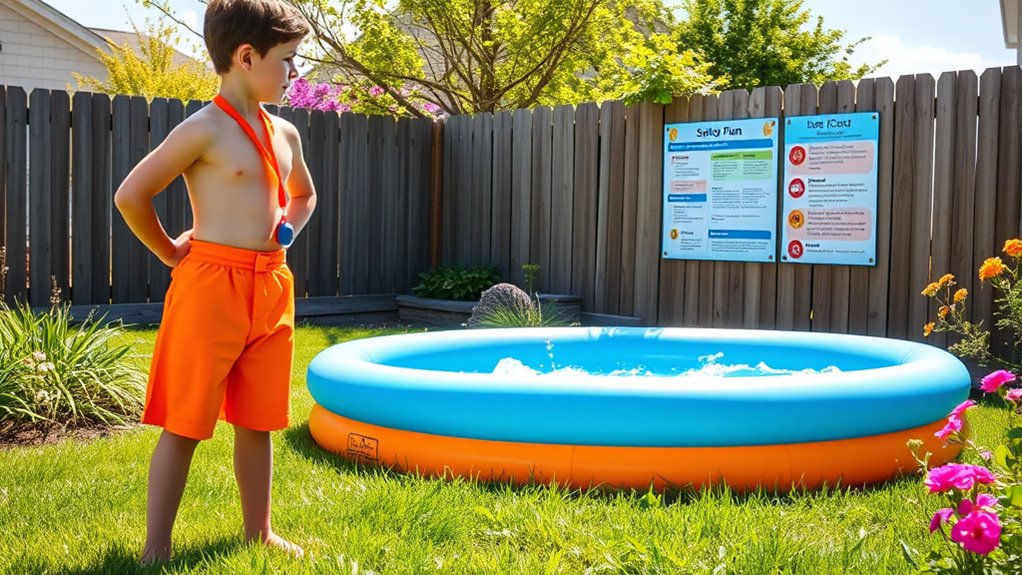
Establishing clear supervision protocols is essential to guarantee safety around your backyard pool. You need to set specific rules about who is responsible for watching the water at all times. Assign a designated adult or responsible teen to supervise whenever the pool is in use, avoiding distractions like phones or conversations. Implement a “no running” and “no diving” rule to prevent accidents. Make sure supervision is continuous—never leave children unattended, even for a moment. Use visual cues like a designated supervising area or a sign to remind everyone of supervision expectations. Consistency is key; ensure everyone in your household understands and follows the protocols. Understanding trust issues and maintaining vigilance can prevent accidents and keep your backyard safe for everyone.
Training Family and Guests in Water Safety

You should teach your family and guests basic water skills to guarantee everyone feels confident around the pool. Conduct emergency response drills so everyone knows what to do if trouble arises. Also, help them recognize water dangers to prevent accidents before they happen.
Teaching Basic Water Skills
Teaching basic water skills is essential to guarantee everyone stays safe around your backyard pool. These skills build confidence and reduce the risk of accidents. Start by ensuring all family members and guests learn to:
- Float on their back and stomach for stability.
- Tread water to stay afloat without swimming.
- Perform simple self-rescue techniques if they get tired or in trouble.
- Use a reaching or throwing assist to help others in distress.
Familiarity with water safety techniques can further enhance your preparedness and response in emergencies.
Practice these skills regularly in a controlled environment. Encourage everyone to ask questions and repeat exercises until they feel comfortable. Remember, the goal isn’t just competence but also confidence around water. Well-trained family and guests are your best defense against emergencies.
Emergency Response Drills
To guarantee everyone knows how to respond quickly in an emergency, conducting regular water safety response drills is essential. Practice helps family members and guests stay calm and act effectively during real incidents. You can simulate scenarios like a person struggling or an unconscious swimmer to reinforce correct responses. Make sure everyone knows their role, whether calling for help, administering first aid, or pulling someone from the water. Use the following table to assign specific tasks during drills:
| Role | Task | Timing |
|---|---|---|
| Lifeguard | Call emergency services | Immediately |
| Responder | Reach and assist the distressed swimmer | Within seconds |
| Observer | Ensure safety perimeter remains intact | Throughout drill |
Regular practice builds confidence and readiness, making your backyard safer. Effective training ensures all participants are prepared to act swiftly and appropriately during emergencies.
Recognizing Water Dangers
How can family members and guests quickly identify potential water hazards before they become emergencies? By staying alert and knowing what to look for. Here are four key dangers to watch out for:
- Slippery surfaces – Wet decks and pool edges can cause falls.
- Unsupervised children – Always ensure kids are within sight, especially near water.
- Broken or loose pool equipment – Damaged ladders or diving boards pose risks.
- Obstructed visibility – Murky water or clutter can hide hazards or struggling swimmers.
Setting Up Visual Safety Alerts and Signage
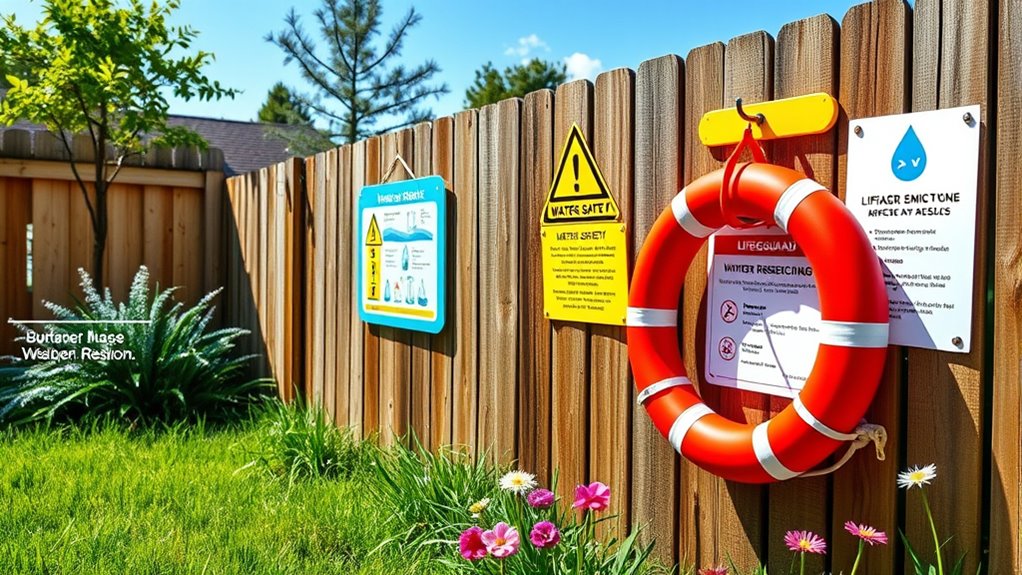
Setting up clear visual safety alerts and signage is essential for maintaining a secure backyard swimming area. You should place signs at key points, such as pool entrances, to warn about depth changes or slippery surfaces. Use bright, easily readable colors like red or yellow to catch attention quickly. Symbols and icons can communicate warnings even to those who don’t speak the language, like “No Diving” or “Children Must Be Supervised.” Ensure signs are weather-resistant and positioned at eye level. Regularly check that all signage remains visible and legible, replacing any that become faded or damaged. Proper signage not only informs guests of potential hazards but also reinforces safety rules, helping everyone stay alert and cautious around the water.
Planning for Emergency Response and First Aid
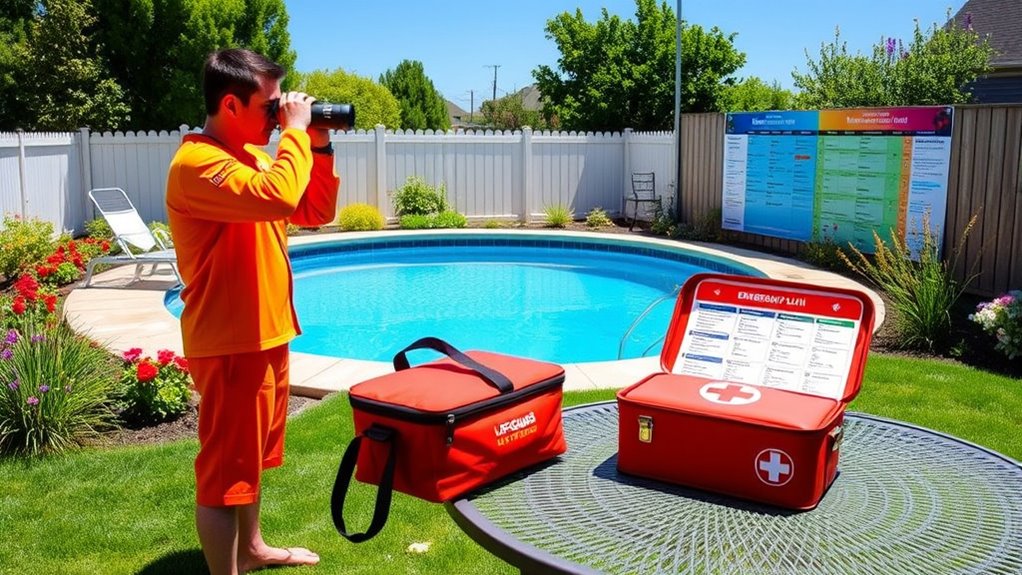
Preparing for emergencies is crucial to ensuring a quick and effective response if an accident occurs in your backyard pool. You should develop a clear plan that includes essential steps to take immediately. First, identify who will call emergency services and what information they need. Second, designate a designated person to perform first aid while others assist or retrieve supplies. Third, keep a well-stocked first aid kit nearby, stocked with bandages, antiseptics, and CPR masks. Fourth, establish a communication method, like a phone or walkie-talkie, so everyone stays connected. By planning these steps ahead of time, you reduce panic and ensure swift action, which can make all the difference in a crisis. Proper planning saves lives and keeps everyone safer.
Practicing Regular Drills and Safety Checks

Regularly practicing drills and conducting safety checks are essential to keep your backyard pool area prepared for emergencies. By scheduling routine drills, you reinforce everyone’s response to potential incidents, ensuring they react calmly and confidently. Practice scenarios like rescuing a distressed swimmer or applying first aid, so your family knows what to do without hesitation. Safety checks also help identify hazards, such as loose fencing or faulty equipment, that could cause accidents. Walk through your safety procedures regularly, updating them as needed, and involve everyone in the process. This consistency builds muscle memory, making emergency responses quick and effective when it matters most. Staying proactive with drills and checks keeps your backyard a safe, enjoyable space for everyone.
Maintaining Your Backyard Safety Systems
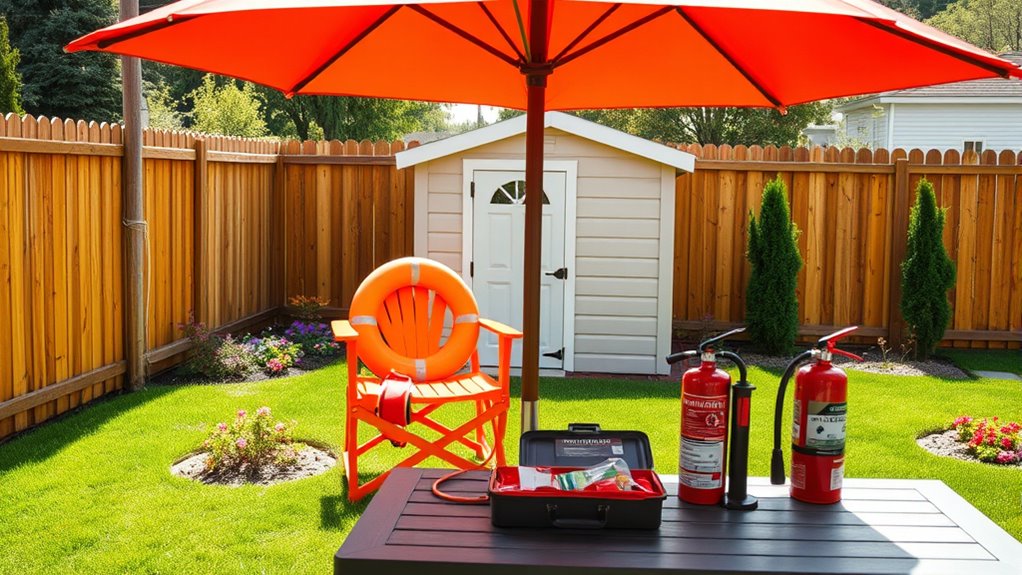
To keep your backyard safety systems effective, you need to actively maintain and inspect them regularly. This guarantees everything functions properly when you need it most. Here are four key steps:
- Check all safety equipment, like life rings and first aid kits, for damage or expiration dates.
- Test alarms and sensors monthly to confirm they’re working properly.
- Clean gutters and drainage to prevent water buildup that could compromise safety.
- Inspect fencing and gates for stability and secure latches to prevent accidental access.
Communicating Emergency Procedures to All Users

Effective communication of emergency procedures is vital to guarantee everyone knows what to do in a crisis. You need to ensure all users understand the plan clearly, whether they’re kids, guests, or neighbors. Post visible signs with simple steps near the pool and key areas. Conduct regular drills so everyone practices their roles, reinforcing the procedures. Use clear, direct language when explaining emergency steps, avoiding confusion. Make certain everyone knows how to alert you or emergency services quickly. Keep communication devices, like phones or whistles, accessible and functional. Encourage questions and feedback to identify gaps. Remember, the goal is to eliminate hesitation during an emergency, so clarity and repetition are your best tools for effective communication.
Frequently Asked Questions
How Often Should I Review and Update My Backyard Emergency Plans?
You should review and update your backyard emergency plans at least once a year. Additionally, do so anytime there’s a significant change, like new equipment, new family members, or after a major weather event. Regular reviews ensure everyone knows what to do and stays prepared. Practice drills help reinforce the plan, so schedule them periodically to identify and fix any weaknesses. Staying proactive keeps your family safe.
What Are Common Mistakes to Avoid When Setting up Safety Equipment?
You should avoid common mistakes like choosing equipment that’s not age-appropriate or failing to keep it accessible. Don’t forget to regularly check expiration dates, batteries, and functionality. Also, avoid cluttering safety gear; it needs to be easy to find quickly. Training yourself and others on how to use the equipment properly is vital. Overlooking these details can delay response times and compromise safety during emergencies.
How Can I Ensure Non-Swimmers Understand Basic Water Safety?
You can guarantee non-swimmers understand basic water safety by providing simple, clear instructions and demonstrations. Use visual aids, like posters or videos, to reinforce key points, and practice with them regularly. Encourage questions and hands-on practice, such as floating or reaching techniques, to boost confidence. Always supervise closely during water activities, and remind them of safety rules consistently to build their awareness and skills effectively.
What Signs Indicate That Safety Equipment Needs Maintenance or Replacement?
Did you know that 80% of drownings happen when safety equipment isn’t properly maintained? You should check your safety gear regularly—look for rust, cracks, or tears in flotation devices, and verify alarms and first aid supplies are functioning and up-to-date. Replace any damaged or expired items immediately. Regular inspections keep everyone safe and prevent accidents, giving you peace of mind during backyard fun.
How Can I Involve Neighbors or Community in Backyard Safety Awareness?
You can involve neighbors and your community by hosting safety workshops, inviting them to safety drills, and sharing tips via neighborhood social media groups. Encourage open conversations about backyard hazards and safety equipment. Organize neighborhood watch programs focused on safety. You might also create a shared safety checklist and ask neighbors to report concerns or suggest improvements. Your proactive approach fosters a safer environment and builds stronger community bonds.
Conclusion
By staying vigilant and prepared, you turn your backyard into a safe haven rather than a hazard. Regularly review your safety plans, keep equipment in check, and practice drills with family and guests. Remember, an ounce of prevention is worth a pound of cure—like planting seeds now for a bountiful harvest later. When everyone knows what to do, you’ll be ready to handle emergencies confidently, safeguarding your loved ones and ensuring peace of mind.



